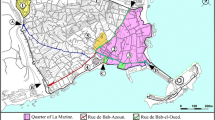Abstract
The recent structuralist model of the social organization of space at Great Zimbabwe, proposed by Huffman, is critically examined in the light of new chronological data. Architectural histories of the Western and Central Valley Enclosures (Posselt and Phillips Ruins respectively) are used to show the complex changes that occur through time in the social ‘meaning’ of spatial organization. It is argued that these changes are not adequately accounted for in Huffman's model. The Western Valley Enclosure, dated on the basis of a large piece of blue-on-white Chinese porcelain of the Honghzi period (Ming Dynasty, AD 1488–1505) recovered from a sealed context, was still occupied when most other areas of Great Zimbabwe were abandoned. Huffman's incorporation of these enclosures into a synchronic structuralist interpretation of the site is therefore probably invalid. These new data highlight the importance of chronological control in the development of structural and symbolic interpretations of Great Zimbabwe.
Résumé
Le modèle structuraliste de l'organisation sociale de l'espace à la Grande Zimbabwe proposé récemment par Huffman est examiné de façon critique, en fonction de données chronologiques récentes. Les histories architecturales des enclos des vallées Ouest et du Centre (Posselt et Phillips Ruins) sont utilisées afin de démontrer les changements complexes subit au cours du temps par la dimension sociale de l'organisation de l'espace. Les auteurs proposent que ces changements ne sont pas reflétés de manière convaincante par le modèle de Huffman. L'enclos de la vallée de l'Ouest est daté par la présence d'un fragment de porcelaine chinoise large, bleu sur blanc, appartenant à la période Houghzi (Dinastie de Ming 1488–1505 AD), trouvé dans un contexte scéllé; ceci prouve que le site était encore occupé alors que la plupart des autres quartiers de la Grande Zimbabwe étaient déjá abandonnés. L'incorporation par Huffman de ces enclos dans l'interprétation synchronique structuraliste du site n'est donc probablement pas correcte. Ces données nouvelles mettent en lumière l'importance du control chronologique pour le développement d'interpretations symboliques et structuralistes de la Grande Zimbabwe.
Similar content being viewed by others
References
Beach, D. N. 1980.The Shona and Zimbabwe, 900–1850. London: Heinemann.
Bent, J. T. 1892.The Ruined Cities of Mashonaland. London: Longmans, Green.
Caton-Thompson, G. 1931.The Zimbabwe Culture. Oxford: Clarendon Press.
Chittick, H. N. 1974.Kilwa: an Islamic trading city on the East African coast. Nairobi: British Institute in Eastern Africa.
Garlake, P. S. 1968. The value of imported ceramics in the dating and interpretation of the Rhodesian Iron Age.J.A.H. 9: 13–33.
Garlake, P. S. 1973.Great Zimbabwe. London: Thames & Hudson.
Garlake, P. S. 1985.Great Zimbabwe Described and Explained. Harare: Zimbabwe Publishing House.
Hall, R. N. 1905.Great Zimbabwe. London: Methuen.
Hall, R. N. and Neal, W. G. 1902.The Ancient Ruins of Rhodesia. London: Methuen.
Huffman, T. N. 1981. Snakes and birds: expressive space at Great Zimbabwe.African Studies 40:131–50.
Huffman, T. N. 1982. Archaeology and ethnohistory of the African Iron Age.A.R.A. 11:133–50.
Huffman, T. N. 1984a. Expressive space in the Zimbabwe Culture.Man 19:593–612.
Huffman, T. N. 1984b. Where you are the girls gather to play: the Great Enclosure at Great Zimbabwe. InFrontiers: Southern African Archaeology Today (eds. M. Hallet al.): pp. 252–65. Oxford: British Archaeological Reports.
Huffman, T. N. 1985. The Great Enclosure and Domba.Man 20:543–5.
Huffman, T. N. 1986. Iron Age settlement patterns and the origins of class distinction in Southern Africa.Advances in World Archaeology 1:291–337.
Huffman, T. N. 1987.Symbols in Stone: unravelling the mystery of Great Zimbabwe. Johannesburg: Witwatersrand University Press.
MacIver, D. R. 1906.Medieval Rhodesia. London: Macmillan.
Masey, F. E. 1911. Zimbabwe: an architect's notes.Proceedings of the Rhodesia Scientific Association 11:37–56.
Mauch, C. 1969.The Journals of Carl Mauch (ed. E. E. Burke). Salisbury: National Archives of Rhodesia.
Robinson, K. R. 1959.Khami Ruins. Cambridge: Cambridge University Press.
Robinson, K. R. 1961a. Excavations on the Acropolis hill.Occasional Papers of the National Museums of Southern Rhodesia 3(23A):159–92.
Robinson, K. R. 1961b. Zimbabwe pottery.Occasional Papers of the National Museums of Southern Rhodesia 3(23A):193–226.
Schofield, J. F. 1926. Zimbabwe: a critical examination of the building methods employed.S.A.J.S. 23:971–86.
Stevens, C. G. 1931. The Zimbabwe Temple.J.R.A.I. 61:181–6.
Summers, R. F. 1961. Excavations in the Great Enclosure.Occasional Papers of the National Museums of Southern Rhodesia 3(23A):236–88.
Summers, R. F. and Whitty, A. 1961. The development of the Great Enclosure.Occasional Papers of the National Museums of Southern Rhodesia 3(23A):306–25.
Theal, G. M. (ed.) 1898–1903.Records of South Eastern Africa. Cape Town: Government of Cape Colony.
Turner, V. 1967.The Forest of Symbols: aspects of Ndenbu ritual. Ithaca: Cornell University Press.
Walton, J. 1956.African Village. Pretoria: Van Schaik.
Whitty, A. 1961. Architectural style at Zimbabwe.Occasional Papers of the National Museums of Southern Rhodesia 3(23A):289–305.
Rights and permissions
About this article
Cite this article
Collett, D.P., Vines, A.E. & Hughes, E.G. The chronology of the Valley Enclosures: implications for the interpretation of Great Zimbabwe. Afr Archaeol Rev 10, 139–161 (1992). https://doi.org/10.1007/BF01117699
Issue Date:
DOI: https://doi.org/10.1007/BF01117699




